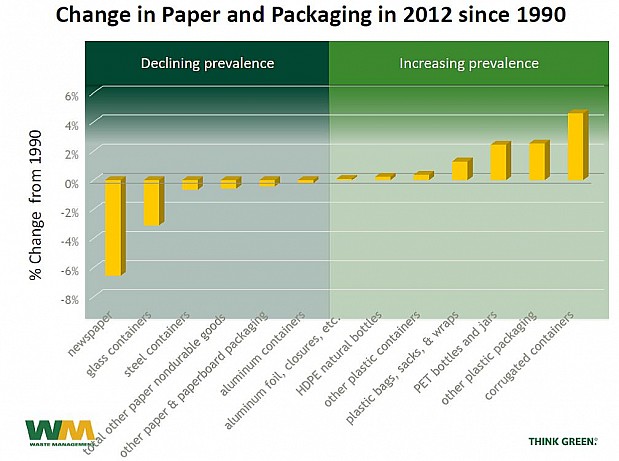March 31, 2015
With NERC’s Spring 2015 Conference: Own the Future - Creative Options to Sustainable Materials Management next week, it seems timely to look at a developing issue in the recycling world—the “evolving ton”.
According to Susan Robinson, Federal Public Affairs Director for Waste Management (EPA Webinar Series, November 13, 2014), per capita waste generation is down 8% since 2000, while the mix of what goes into recycling is changing dramatically. This is not a new discussion. Dylan de Thomas, Editorial Director for Resource Recycling and Chaz Miller, State Programs Director for the National Waste & Recycling Association, have been writing about the “evolving ton” for several years now. View their keynote address at NERC’s Fall 2014 conference.
Newspaper and glass generation are in steep decline. Steel is declining, at least in its use in packaging. Paper board and similar paper packaging is waning in use. Even aluminum has seen a reduction. On the rise—aluminum foil/closures; HDPE natural bottles and other plastic containers; plastic bags, sacks, and wrap; PET bottles and jars; other plastic packaging; and, corrugated containers. No surprise in the rise of plastics since most of us see this in our product purchases. However, what does this changing mix in what’s collected in the recycling stream mean for the future of materials management? What is the impact on processors? And, what does it mean for materials management professionals as we plan and implement new strategies and programs?
Newspaper historically made up around 60% of the material collected in residential recycling. Now with the rise of single-stream, paper is often marketed as a “curbside mixed” grade. According to Ms. Robinson, paper now makes up 45-60% of the residentially collected material processed at MRFs, while 40-55% of the mix is containers.
Nonmarketable glass and other residue continue to increase; currently comprising on average 16% of inbound material for processors handling single-stream materials—with residue running as high as 50% of inbound material. Another issue on the rise is plastic film, noted by Ms. Robinson as the “single biggest” processing problem at MRFs. Collected commercially and at special collection boxes, film has strong market opportunity. However, when it comes into single-stream processing it gets tangled up in the processing equipment.
Plastics, according to Ms. Robison, now make up 12.7% by weight of the waste stream and 25% by volume. Plastic bottles continue to be light-weighted, changing the monetary returns from these traditional plastic “money makers” in the recycling stream. From a processing angle, the results from this evolving ton mean that more material must be processed to make a ton of marketable commodity, contributing to a rise in processing costs. And, material revenues are falling.
On a related topic, I had the privilege of presenting at the MassRecycle R3 Recycling and Organics Conference yesterday. Ted Siegler with DSM Environmental Services was a keynote speaker. Mr. Siegler addressed the changing ton issue in terms of its impact on stagnant and even falling recycling rates. While single-stream is bringing in more recyclables for processing (albeit along with rising contamination), more plastics in the recycling stream and light weighting in general are having an impact on the nation’s recycling rate.
For recycling coordinators this makes life more difficult as we go to plan new programs and educate the public about the importance of recycling. Conflicting announcements about single-stream bringing in more recyclables, while recycling rates remain stagnant or fall, contributes to public confusion over the benefits of their recycling efforts. Looking at new ways to “count” our recycling/recovery will need to be considered as well.
Adding to the mix is increasing interest in food scrap diversion, electronics collections, product stewardship and extended producer responsibility, new approaches to education for single-stream recycling programs, a rise in reuse programs, zero waste, and the circular economy. Interesting times for materials management indeed!
By Athena Lee Bradley



Comments (0)
Add a Comment